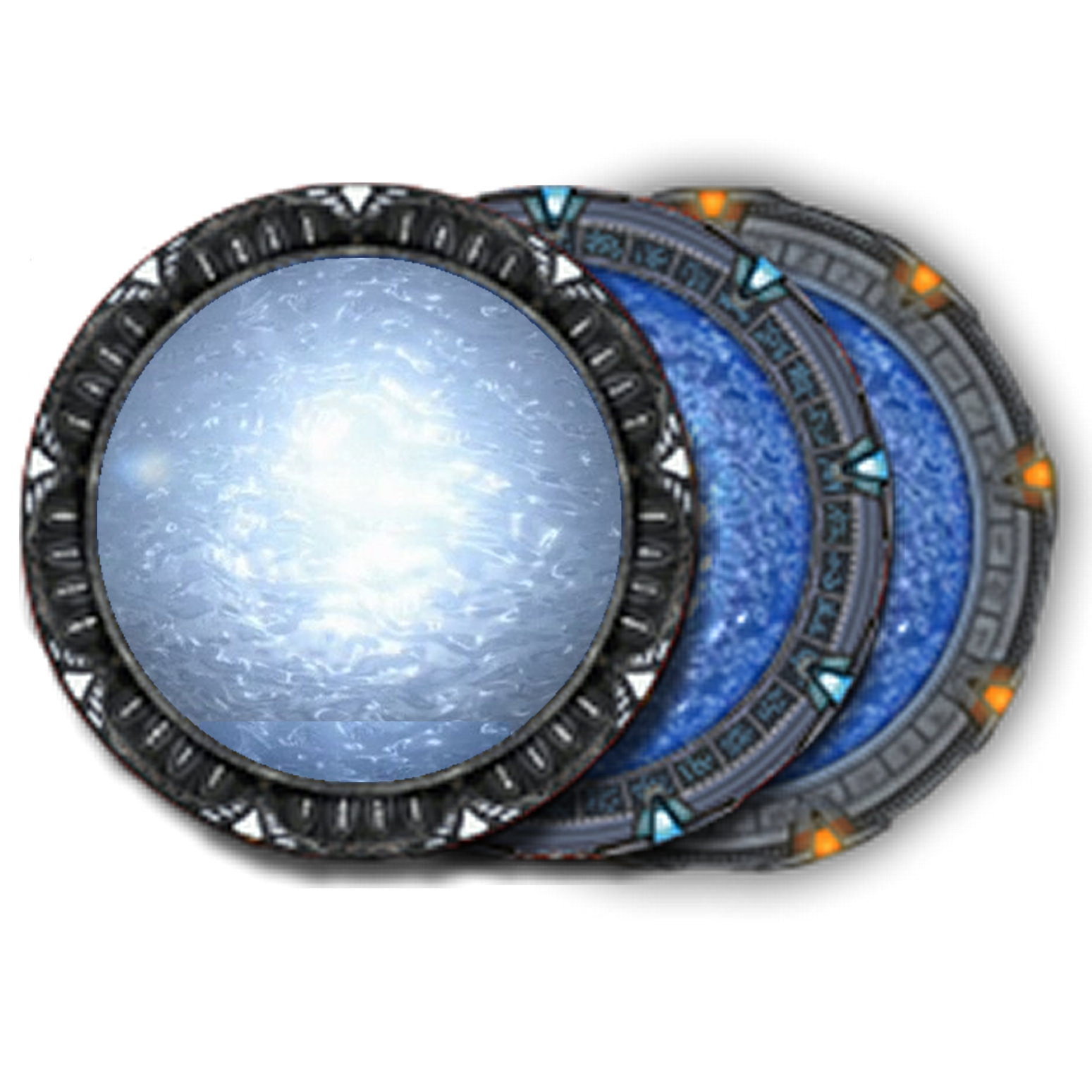Stargate franchise
| Stargate | |
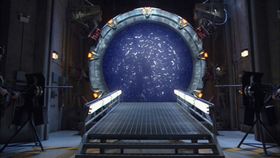 An active Stargate, the main device used in the franchise. | |
| Creator | Roland Emmerich, Dean Devlin |
|---|---|
| Original work | Stargate |
| Print publications | |
| Novels | Novels |
| Comics | Comics |
| Films and television | |
| Films | Stargate Stargate: The Ark of Truth Stargate: Continuum |
| Television series | Stargate SG-1 Stargate Atlantis Stargate Universe |
| Animated series | Stargate Infinity |
| Games | |
| Role-playing | Stargate SG-1 Roleplaying Game |
| Video games | Stargate: Resistance |
Stargate is an adventure military science fiction franchise, initially conceived by Roland Emmerich and Dean Devlin. The first film in the franchise was simply titled Stargate. It was originally released on October 28, 1994, by Metro-Goldwyn-Mayer, Carolco and Studio Canal, and became a hit, grossing nearly $200 million (USD) worldwide.[1][2] Three years later, Brad Wright and Jonathan Glassner created a television series titled Stargate SG-1 as a sequel for the film.
In addition to film and television, the Stargate franchise has expanded into other media, including books, video games, and comic books. These supplements to the film and television series have resulted in significant development of the show's fictional universe and mythology. In 2008, the films Stargate: The Ark of Truth and Continuum were released direct-to-DVD, which in total grossed over $21 million in the United States. In 2002 the franchise's first animated series, Stargate Infinity, began airing, which holds no canonicity in the franchise despite its Stargate SG-1-inspired plot. In 2004, the TV series Stargate Atlantis was released as a spin off from Stargate SG-1 and a third series, Stargate Universe, premiered on October 2, 2009. Stargate Universe was cancelled during its second season, leaving it on a cliffhanger. Then on April 17, 2011, Stargate producer Brad Wright announced that any plans for the continuation of the franchise had been cancelled indefinitely, ending 17 years of Stargate television production.[3]
Premise
Stargate productions center on the premise of a "Stargate", a ring-shaped device that creates a wormhole enabling personal transportation to complementary devices located cosmic distances away. Under the control of the United States government, the Stargate discovered on Earth is kept a secret from the public. This allows for storylines to present no contradiction between depicted events and reality, an effect compounded by setting Stargate in the present day and depicting Earth accurately, with any unrealistic technology originating solely from alien civilizations. These extraterrestrial civilizations are typically more pre-industrial than scientifically advanced and are almost always human. Together, this allows for stories predominated by human interaction in Earth-like environments, an unusual feature for a science fiction franchise focused on exploration of other worlds.
In the story, this is explained as being the result of alien interference in Earth's distant past—the concept influenced by the theories of Erich von Däniken.[4] Many ancient mythologies are shown to be the result of aliens who had visited Earth posing as gods by using their technology to give the impression of deific power. While some of these aliens had benign intentions, a race later known in Stargate SG-1 as the "Goa'uld" used Stargates to move slaves from Ancient Egypt to other habitable planets, simultaneously being responsible for the Egyptian religion and culture. Following a successful rebellion, the Goa'uld fled Earth, and the Stargate was buried and forgotten until modern times, when the United States acquired it following an archaeological dig. With the rediscovery of the function of the Stargate, the galaxy becomes a source of knowledge as well as threats, and the attention of the Goa'uld is drawn once more to Earth.
Stargate network
Several million years ago, an ancient race of advanced humanoid beings, now known as the Ancients, created a device capable of near-instantaneous transportation across the universe by means of a subspace wormhole. This device, which has been used by countless races since its creation, has more commonly become known as a "Stargate"— a name, discovered by Dr. Daniel Jackson, from hieroglyphics written by humans on Earth thousands of years ago. While various cultures have created their own name for the device, Stargate is among the most common used.
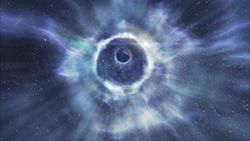
A Stargate itself is a device made out of a volatile mineral known as naquadah. It is between two Stargates that travel is possible. A stable wormhole in a Stargate is achieved by dialing the correct address in a mechanism named a DHD. In a DHD, an address of six symbols (representing constellations as seen from Earth for the Milky Way galaxy-style of gate) is imputed, plus a point of origin (a symbol unique to a particular Stargate that represents the location a person is dialing from), bringing the total up to seven symbols for an in-galaxy address. Eight symbols are required to establish a lock with a Stargate in another galaxy (such as the Pegasus galaxy). Nine symbols are required to dial Stargates that reside far across the universe - one notable destination is the gate aboard the Ancient spaceship Destiny, which was designed with the purpose of exploring the universe and Stargate networks established by the Seed ships that were launched prior. The Stargate contains nine chevrons spaced equally around its circumference. With each symbol that is locked, so is a chevron, making nine symbols the maximum number of symbols (or glyphs) that can be input. The design of the Stargates themselves tend to vary between galaxies. Three distinct designs are known; Stargates in the Milky Way galaxy, Pegasus galaxy, and that which resides on Destiny and are constructed by Seed ships. The varying designs of Stargates are largely the result of technological advancement; Destiny-style gates (the most primitive in design and function) were constructed first, followed by Milky-Way model gates, and lastly Pegasus-style gates.
Stargates play an extremely important role in each of the Stargate series. It is through these gates that races, mostly consisting of humanoid-like beings (particularly humans themselves), trade and explore. However, several races (such as the Goa'uld) often use the Stargate networks in far different, and deadlier, ways. Such races play an important role in the Stargate series, and are the driving force for the shows themselves.
Tau'ri
The Tau'ri are the main protagonists in the Stargate series. "Tau'ri" is the term used by the inhabitants of the Milky Way to refer to Earth and human beings from Earth. The word means "first ones" or "those from the first world" in the Goa'uld language in the sense that human life in the Milky Way began on Earth. While it originally applied to all human beings in the galaxy, the term has come to apply specifically to the humans who currently live on Earth as the Stargate Program proceeded to explore the galaxy. In the Stargate universe, the Tau'ri are the predominant protagonists in the fight against galactic oppressors, fighting a multi-front war against several other major races. During the first six years of the series, the Tau'ri were largely limited to what they could achieve in the way of repelling enemy forces due to the "primitiveness" of the technology in their possession, as compared to that of the hostile races they faced - notably the Goa'uld. It wasn't until season six and beyond that the Tau'ri were truly beginning to emerge as a powerful force in the galaxy (SG1: "Children of the Gods", "Thor's Hammer", "Red Sky", "Unending").
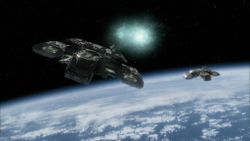
Around Stargate SG-1's sixth season, as a result of six years of exploration and discovery, the Tau'ri became powerful and knowledgeable enough to construct their first battlecruiser, Prometheus, which was the sole member of the BC-303-class. Despite being rather primitive in comparison to the spaceships of most other races, this ship represented a massive step in the Tau'ri's development. Prometheus served as the flagship of the Tau'ri fleet for several years and lived long enough to see the downfall of the Goa'uld. Through it's existence, it played critical roles in Earth's defense (such as in the Battle of Antarctica). However, as the Tau'ri became more advanced towards the eight season of Stargate SG-1, the Prometheus-class series of vessels became exceedingly obsolete. Therefore, a new class of ship was designed, the 304, also known as the Daedalus-class after the first ship of the class.
Since the 304's creation, six such vessels have been constructed, including Daedalus, Odyssey, Korolev, Apollo, Sun Tzu, and George Hammond. These ships are one of the most advanced creations in the Tau'ri's possession. 304s are the ultimate culmination of everything the Stargate Program sought to achieve— the acquisition of technology capable of defending Earth from its enemies. These ships far rival the spaceships of most races in the Stargate universe and have ascended the Tau'ri to a place of major power in two galaxies (the Milky Way and Pegasus). These ships, and the Tau'ri themselves, became even more powerful in Stargate SG-1's series finale "Unending" after the demise of the Asgard — an extremely advanced race of humanoids, and perhaps the closest ally of Earth. In order to carry on their legacy after their subsequent demise, the Asgard gifted to the Tau'ri their complete history in an advanced computer core, which also contained the knowledge to construct advanced Asgard technology. 304s have appeared in all three series, but most notably in Stargate SG-1 and Stargate: Atlantis. However, spaceships in the Stargate series largely only serve as plot devices to facilitate the progression of an episode, and very few episodes have taken place solely aboard spaceships, with the exception of Stargate Universe.
Stargate and Stargate SG-1

The whole premise of the Stargate franchise began with the feature film Stargate, released theatrically in 1994 by MGM. It was directed by Roland Emmerich, written by Emmerich and Dean Devlin and starred Kurt Russell, James Spader and Jaye Davidson. The film served to introduce the Goa'uld as the main antagonists and introduced the Stargate itself. However, several aspects of the film differ from the series (see Stargate canon).
Stargate SG-1 is a television spin-off of Roland Emmerich's 1994 film Stargate. The series was developed for television by Brad Wright and Jonathan Glassner, who together wrote the two-hour pilot episode "Children of the Gods", which was set to take place more than one year after the events of the movie. "Children of the Gods" originally aired on July 27, 1997 and "Unending," the final episode of the series, aired in the UK on March 13, 2007 and in the US on June 22, 2007.
Overview
Although an overall story arc was present from the start, the episodes of the first few seasons of Stargate SG-1 were mostly episodic, depicting the SG-1 team traveling to a different planet in each episode. Occasionally, this formula was broken slightly, usually when they dealt with NID agents, in which case the episode would take place mostly on Earth. Gradually, the show became less episodic and more serialized. Over its ten-year run, the show built up a complex mythology involving the history of the galaxy and introduced many new alien races, such as the Ancients and the Asgard, whereas the only true alien to appear in the original film was Ra.
Originally, the Goa'uld, namely Apophis, were the principal villains of the series. However, at the end of season three a new threat was introduced, the Replicators. Although they appeared in multiple episodes over the next five seasons, they were never as widely depicted as the Goa'uld were. In "Enemies," the opening episode of season five, Apophis was finally defeated and Anubis replaced him as the main villain for the next three seasons. Anubis and the Replicators were defeated in one blow at the end of season eight. Even though the Goa'uld were not completely destroyed, a new race called the Ori became the principal villains for the show's final two seasons.
The tone of the show also changed considerably over the course of its run. Much like the original film, the earlier episodes were mostly serious in character with an underlying comic tone. Later, the show became much lighter and occasionally even verged on borderline self-parody. The introduction of the Ori in season nine and the additions of Claudia Black and Ben Browder continued the show in its comedic and light hearted aspects.
Goa'uld
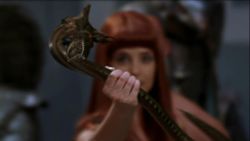
The Goa'uld are a race of sentient parasitic, snake-like beings that can take over the host bodies of a variety of species. The Goa'uld served as the main antagonists for the first eight seasons of Stargate SG-1 until they were largely defeated in the episode "Reckoning", Part 2. They are also extremely ego-maniacal due to their genetic memory and the sarcophagus technology. Races that refused to serve them would be completely destroyed without compromise (SG1: "Children of the Gods", "Thor's Hammer", "The First Ones"). The Goa'uld served largely as the driving force for Stargate SG-1 in its early seasons. The constant Goa'uld threat resulted in the SGC's mandate to acquire technology capable of defending the planet from them.
The Goa'uld themselves are small snake-like Symbiotes that require a host body (SG1: "Children of the Gods"). Once they burrowed into body which can be accomplished by piercing the skin in the neck, the parasite begins to wrap itself around the Human spine. The symbiote then weaves itself around the nervous system where thin filaments are extended that go up into the brain itself (SG1, "The Enemy Within"). Within a host, a Goa'uld parasite has complete control of the host's body. A Goa'uld also gives its host near perfect health, increased strength, and increased intelligence. The highest authority among the Goa'uld race included the ranks of the System Lords, who fielded vast armies and fleets of ships under their command as well as warred with one another for dominance of the galaxy.
The strength of the Goa'uld's power was the millions of Jaffa they kept subservient to them by assuming the persona of their "gods". These Jaffa were eventually the Goa'uld's undoing. When the numbers of rebel Jaffa grew, they were eventually (with massive help from the Tau'ri) able to overthrow their Goa'uld masters and establish a Free Jaffa Nation. Because of this, the Jaffa nation has become a powerful force with a fleet of former Goa'uld ships in their possession. They are sporadic allies of the Tau'ri due to rising political turmoil.
Ori
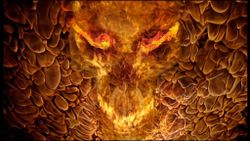
The Ori were a race of ascended beings who used their knowledge and power as justification to demand the worship of mortal beings. Millions of years ago, the Ori lived together with the Ancients as a single, united society in a distant galaxy as the Alterans. Unfortunately, at some point, a split occurred among the Alterans: The Ancients began to devote themselves to science, while the Ori became more and more religious. This division eventually became so great that the Ori attempted to destroy the Ancients. To avoid a war, which was contradictory to their beliefs, the Ancients departed their home galaxy for the Milky Way.
The Ori conceived the Origin faith, one that puts them in the center of creation, and wrote down their word in the Book of Origin to be administered to followers through Priors, missionaries and teachers of Origin. The Ori use the Doci, the chief Prior, as their "mouthpiece" for communicating with lesser beings. They are able to possess his body to spread their demands and will (SG1: "Avalon", Part2, "Origin").
The Ori serve as the main antagonists for Stargate SG-1 in seasons 9 and 10. After being discovered by Daniel Jackson and Vala Mal Doran, the Ori were subsequently alerted to the presence of humans in the Milky Way galaxy, and began a religious crusade in an effort to convert the galaxy's population to Origin. In season 10, the Ori manage to sent a fleet of warships to the Milky Way, capable of rivaling even the most advanced spaceships. However, in the SG-1 series finale, the Tau'ri were gifted the most advanced Asgard shield and weapon technology, capable of successfully combating Ori ships.
Several attempts to destroy the Ori and their followers have taken shape, such as by searching for and using Ancient technology, such as the Sangraal and Ark of Truth. The Sangraal (which SG-1 searched for through the last half and season nine and the first half of season ten) is an Ancient device that is capable of, and was used to, destroy the Ascended Ori. However, despite the Ori themselves dieing in Season 10's "The Shroud", their followers were still very much a threat and were still carrying on their crusade (oblivious to the fact that their "gods" were dead). The Ori story arc came to a conclusion in the Direct-to-DVD movie Stargate: The Ark of Truth, in which SG-1 travels to the Ori's galaxy of origin (via the Odyssey) and finds an ancient device known as the Ark of Truth. This device, when found, was used to show the followers of Origin the faults of the religion, thus ending the Ori campaign and story arc.
Stargate Infinity
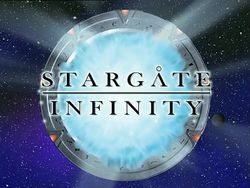
- WARNING: The following is part of the officialy Stargate licensed products, but is not considered as part of the Stargate canon in Semantic Stargate Wiki.
Stargate Infinity was an animated spin-off of Stargate SG-1 that lasted one season, from 2002 to 2003. Many Stargate fans consider Infinity to be of low-quality and Brad Wright has stated that it should not be considered part of the SG-1/Atlantis/Universe canon.
Overview
Stargate Infinity is set 30 years after the feature film in which the Tau'ri first used the Stargate and traveled to Abydos. According to the show, 30 years later the Stargate had become public knowledge and some aliens had become citizens of Earth (or of countries on Earth). The show's storyline followed a veteran member of the SGC, Major Gus Bonner, who leads a team of young recruits through the gate after being framed by an alien infiltrator of the hostile Tlak'kahn race (the Goa'uld having long since been defeated; this was written years before their defeat was even conceived on SG-1). The team must travel from world to world until they find the evidence to clear their names while learning about the unique cultures in the galaxy, alongside learning about themselves in the process. This plot was never resolved.
Stargate Atlantis

Stargate Atlantis is a television series spin-off from Stargate SG-1, which began airing in 2004, and concluded after five seasons. "Enemy at the Gate", the final episode of the series, aired on January 9, 2009. A follow-up film, titled Stargate: Extinction, was originally intended to continue the show's plot after cancellation. However, it has since been shelved along with any subsequent movies that were to follow. Atlantis is followed by a third series, Stargate Universe.
Overview
Stargate: Atlantis, which aired July 16, 2004, is the first spin-off series of Stargate SG-1. The show takes place after the finale of Stargate SG-1's seventh season, in which SG-1 discovers an advanced outpost under the ice of Antarctica built by the Ancients. In the premiere episode of Stargate: Atlantis, entitled "Rising" (which takes place after SG1's episode "New Order", Part 2), an eight symbol gate address is found in the Antarctic outpost that leads to the long sought after Lost City of the Ancients — known as Atlantis. The search for this city had been an ongoing theme since the sixth season of Stargate SG-1.
An international expedition is sent through the Stargate to the far off Pegasus galaxy where the Ancient City-ship of Atlantis resides. However, soon after the discovery of this incredibly advanced city, the Atlantis expedition encounters a terrible enemy known as the Wraith. Throughout the series, the Wraith serve as the main antagonists, with the Atlantis expedition being the protagonists. The ultimate driving force of the series is the protection of Atlantis and the discovery of advanced Ancient technology, continuing the SGC's original mandate.
The show itself has the same feel as the later seasons of Stargate SG-1 in that the overall atmosphere is light, with the exception of more serious moments.
Ancients
The Ancients, also known as the Gate Builders or Anquietas, in their language, were those Alterans who left their home galaxy for the Milky Way galaxy and seeded it with life. They are one of the most advanced races known to have existed, having evolved for millions of years prior to the present day and reaching their level of technology long before humanity evolved on Earth. They are best known as the builders of the Stargates and Atlantis, and most of them now reside on a higher plane of existence with near infinite knowledge and power. While not directly involved in the show, the Ancients set the stage for the entire Stargate universe by creating the Stargate, Atlantis, and Destiny.
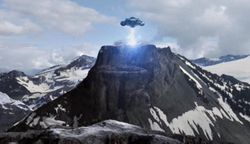
Several million years ago, the Ancients were once part of a race of beings known as the Alterans. However, due to contradicting ideologies, a great schism occurred. In its wake left two distinct cultures: the Ori and the Ancients. These Ancients then proceeded to Earth, where they established a new home and lived for several more million years. However, only a few million years ago, a great plague swept the galaxy and the Ancient were forced to leave. In the City-ship Atlantis, they set off for the Pegasus galaxy where they established a new Stargate network (as they did in the Milky Way) and settled on a planet named Lantea.
The Ancients lived in peacefully and prosperously in Pegasus for several million years— creating a vast empire that spanned the entire galaxy. However, with the emergence of the Wraith, which they themselves played a role in creating, this empire would soon change forever. These Wraith grew in number and technological power, capable of inflicting serious damage to the Ancients. When war between the two races broke out, the Ancient's technological advancement was able to keep the Wraith at bay and enable them to win almost any battle against them. However, as the Wraith grew in number, the Ancients shrank and, after over a hundred years of fighting, Atlantis was the last city in the Ancient's domain in a galaxy conquered by the Wraith. Seeing no way they could win, 10,000 years ago, the Ancients enacted measures to protect their city and evacuated through the Stargate to Earth, hoping that they would, one day, be able to return. Stargate Atlantis picks up 10,000 years later, when the Tau'ri find the Pegasus galaxy in much the same state it was in when the Ancients left— controlled by Wraith.
Atlantis
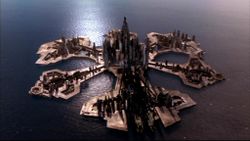
Atlantis, also called the Lost City of the Ancients, the City of the Ancestors or Atlantus in Ancient, is a city-ship built by the Ancients several million years ago, and has approximately the same internal space as found in Manhattan. The Ancients left the Milky Way galaxy several million years ago for the Pegasus galaxy, taking Atlantis with them, and settled on a planet they named Lantea. Millions of years later, after the Lanteans—the name the Ancients came to be known by—submerged the city to protect it from their enemies, the Wraith, and returned to Earth through the Stargate. Their story, over time, inspired the Tau'ri myth of Atlantis.
Atlantis was the capital of the Ancient domain and is one of the Ancient's last surviving City-ships in existence. Atlantis is the primary setting for Stargate: Atlantis and is perhaps the Tau'ri's most advanced asset.
Wraith
The Wraith are a vampiric, hive-based species that harvest the 'life-force' of other humanoid beings for nourishment through sucker organs on their palms. They are also the main antagonists of Stargate Atlantis. Countless worlds in the Pegasus galaxy live in constant fear of the Wraith, who return periodically to cull their human herds. The Ancients s(also called Lanteans) first encountered the Wraith many thousands of years ago. After arriving in the lifeless Pegasus galaxy with Atlantis, the Ancients seeded several planets with humans and Stargates. One of the planets held a creature called the Iratus bug, which began feeding from the humans. Eventually, they began to take on advantageous human characteristics, such as larger brain mass, bipedal locomotion, and opposable digits. Once awoken, the Wraith went to war with the Lanteans and fed upon the humans of the Pegasus Galaxy (SGA: "The Gift").
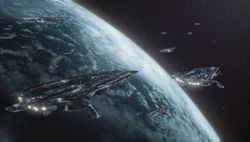
The Wraith continued their feeding pattern where they would abduct humans and take their life force after which they entered into hibernation; allowing the human herds to grow while they slumbered. While this happened, they left a few caretakers to watch over them until the time was right to awaken. This cycle continued for 10,000 years until the Atlantis expedition arrived in the Pegasus galaxy and occupied the Ancient city of Atlantis. The Wraith first encountered the humans of Earth in Stargate: Atlantis' premier episode "Rising". In time, however, with the lack of food and the natural territorial instincts of the Wraith, they entered into a civil war. Stronger Wraith hives began to attack weaker ones for control over the feeding grounds of the galaxy (SGA: "Allies"). The Atlantis expedition has relied on this civil war to keep the Wraith in a state of disarray and successfully strike against them in this disunited state.
The Wraith are focused around a hive-based society similar to some species of insects, but are not a collective mind despite their telepathy. Their society and culture was very different when compared to that of humanity (SGA: "The Queen"). The leaders of a hive typically consisted of female Hive Queens who are in command of a Hive Ship. Hive Ships are the main component of the Wraith fleet, and the centerpiece of their entire society. Hive Ships function in a role very similar to the city-ships of the Ancients.
Stargate Universe

Stargate Universe is the title of the third science fiction television series in the Stargate franchise. Produced by MGM, the show entered production in early 2009, and premiered on October 2, 2009 on Syfy and on October 6, 2009 on Sky1 in the United Kingdom and Ireland. Stargate Universe is filmed and produced in Vancouver, Canada, as with the preceding series. The final episode of Stargate Universe aired on May 9, 2011 in North America.
Overview
After unlocking the mystery of the Stargate's ninth chevron, a team of explorers end up on an unmanned spaceship called Destiny - launched by the Ancients at the height of their civilization millions of years ago as a grand experiment to explore the universe, set in motion but never completed. The crew thus travels through the far reaches of the universe, connecting with each of the previously launched Stargates, in the hope of finding a way home.
Stargate Universe, while still having occasional comedic moments, has more of a dark feeling compared to the other Stargate series. SGU is much more character driven and puts more emphasis on internal conflicts than external (the series largly lacked a persistent external antagonist). SGU, opposed to being driven by such an antagonist, is more focused on the journey home and exploration.
Destiny
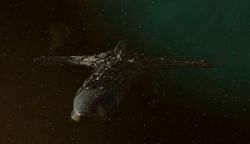
Destiny is a ship from the Ancient fleet, build and launched over fifty million years ago from Earth. The Ancients launched several automated ships prior to Destiny, each with the purpose of constructing and seeding Stargates throughout the numerous galaxies they crossed, with Destiny itself following in their path to explore those planets and piece together fragments of a complex message embedded in the fabric of the universe itself. After beginning this process, the Ancients initially planned to wait until the ship reached a sufficient distance from Earth to board it. However, because of other endeavors, such as ascension, they never followed through on the plan. Because of this, Destiny has continued on a pre-programmed path on its journey throughout the stars, alone, for millions of years. With the arrival of a Tau'ri expedition in 2009, Destiny has a new crew.
Destiny itself is relatively flat and triangular in shape. The left and right sides are markedly concave, while the aft portion of the ship is convexly rounded. The ship is very long and becomes more narrow towards the bow. The surface of the ship is covered with layers of textural elements, including a large number of double-barreled weapon turrets. The ship also contains much advanced technology, but it surpassed by more "recent" constructions, such as Atlantis.
Universe
Technology
The technology in the Stargate series ranges from extremely advanced to basic medieval technology. Several advanced cultures, such as the Goa'uld, Ancient, Asgard, and more recently the Tau'ri, utilize such technologies as plasma weaponry and crystals for memory storage. Holographic displays and devices capable of producing 3-dimensional images have also been featured, as have invisibility cloaks and energy shields. However, this more advanced technology has only been utilized by a mere few of the races featured in Stargate.
Races and Cultures
Many races in the Stargate series have a relation to those in ancient Earth culture. For example thousands of years ago, the Goa'uld Ra controlled Earth and heavily influenced Egyptian culture. In this respect, the pyramids were created to serve as landing pads of Goa'uld ships. Hieroglyphs actually compose the Goa'uld language and many architectural/design elements in Egyptian society originate from the Goa'uld. Other such races are the Asgard, which inspired Nordic legends on Earth, and the Ancients, which influenced medieval culture. In both the Milky Way and Pegasus galaxies, humans (or humanoid-like beings) account for the majority of the sentient population. In the Milky Way galaxy, human life began on Earth. Thousands of years ago, the Goa'uld Ra took some of these humans and distributed them to planets across the galaxy to serve him. Whilst on these separate planets, numerous human populations were able to develop and flourish (some more than others) across the galaxy.
In the Pegasus galaxy, human life was seeded by the Ancients. At the present time, humans live on many planets under constant threat of Wraith cullings. Some of them worship the Ancients as gods, and a very select few have become Wraith worshipers. While some cultures passively wait in fear from one culling to another, some make attempts to break this vicious cycle, building shelters in an attempt to hide from cullings (SGA: "Vengeance"). Others have found ways to fight the Wraith (like the Genii and Hoffans). The Travelers chose to completely abandon their home planet(s) and have been able to to avoid any contact with Wraith by creating generational ships and living there for generations. Some civilizations possess heritage from the Ancients. Sometimes on these planets, the ability to control Ancient technology makes a human the rightful ruler in the eyes of fellow citizens (SGA: "The Tower", "Harmony").
Very seldom have races that are truly "alien" in appearance been featured in the Stargate series - most appear either to be very humanoid or entirely human. Furthermore, only a handful of the countless races featured have not spoken English. This is likely the case in order to allow for the faster progression of each episode's plot. However, many races do have their own language and style of writing, but they are mostly shown speaking in English. Stargate Universe is the only series to break this trend. As the Destiny resides on the far side of the universe, thus far none of the races encountered have appeared human or spoken a language understandable to the expedition. However, alien encounters occur far less often in SGU as opposed to the other series in the franchise, and therefore this trend has not significantly hindered the progression of an episode.
DVDs
In addition to the Stargate DVDs released (which include entire season releases and special collections of episodes), several direct-to-DVD Stargate movies have been released.
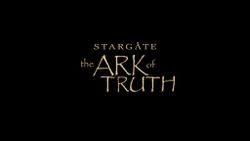
Stargate: The Ark of Truth
Stargate: The Ark of Truth is a direct-to-DVD movie written and directed by Robert C. Cooper. The film is the conclusion of Stargate SG-1's Ori arc, and picks up after the SG-1 series finale, but takes place before the fourth season of Stargate: Atlantis. The movie's plot centered around SG-1 taking the Odyssey to the Ori's home galaxy in search of the Ark of Truth— an Ancient device capable of showing the followers of Origin their religion's faults. The Ark of Truth was released as a Region 1 DVD on March 11, 2008. British Sky One broadcasted the film on March 24, 2008, followed by the Region 2 DVD release on April 14, 2008 with the Region 4 DVD release on April 9, 2008.
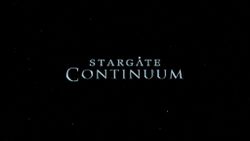
Stargate: Continuum
Stargate: Continuum was the second Stargate film to be released on DVD following the end of Stargate SG-1. It is written and directed by Brad Wright and stars Richard Dean Anderson, Ben Browder, Michael Shanks, Amanda Tapping, Christopher Judge and Claudia Black. The film was released July 29, 2008. The movie's plot revolved around time travel. After the Goa'uld Ba'al went back and time and prevented the Stargate Program from ever existing, a new timeline was created— a timeline in which the Goa'uld still ruled the galaxy. During the film, SG-1 worked to correct the timeline and stop a subsequent Goa'uld attack on Earth.
Future movies
Two more Stargate movies were planned for production including Stargate: Extinction and Stargate: Revolution. Extinction was planned to continue the story line of Stargate Atlantis, which would take place shortly after the events of it's series finale, "Enemy at the Gate". Revolution was planned to be a stand-alone Stargate SG-1 movie revolving around the character of Jack O'Neill. A possible third movie was also planned in order to conclude the cancelled Stargate Universe story line.
However on April 17, 2011, Stargate writer and executive producer Brad Wright announced that the Stargate Universe movie is not going to happen. He also confirmed that the proposed Stargate SG-1 and Atlantis movies have been permanently shelved, along with another movie idea he had been trying to get a greenlight on, which would have combined and involved cast members of all three series.[3]
Reboot
On September 5, 2013, during an interview with Digital Spy, Emmerich said that he and MGM are planning a new Stargate as a reboot with a trilogy.[5] On May 29, 2014, it was announced that MGM and Warner Bros. are partnering with both Emmerich and Devlin for a reboot of Stargate as a trilogy with Emmerich directing and Devlin producing.[6] On November 17, 2016, Devlin told Empire Online that the plans to make a reboot of a potential new series are stalled.[7]
Other media
- WARNING: The following is part of the officially Stargate licensed products, but is not considered as part of the Stargate canon in Semantic Stargate Wiki.
Literature
There are three series of novels based on the Stargate franchise, one based on the original Stargate film and two based in Stargate SG-1 and Stargate: Atlantis. A series of books written by Bill McCay were published from 1995 to 1999 that were unofficial sequels to the film. These were produced by consulting the original notes made by Dean Devlin and Roland Emmerich, in an attempt to envision where the film "would have gone". Neither party has commented on whether McCay's interpretation was correct. Despite the fact that he attempted to remain close to the original vision, the subsequent television series Stargate SG-1 (which began under an entirely independent development) developed the story along different lines, making no attempt to reconcile the plot lines of the books. This marked the first major branching of the franchise.
Later, from 1999 to 2001, Roc Books published four novels based in Stargate SG-1 written by Ashley McConnell. In 2004, UK-based Fandemonium started a new series of licensed tie-in novels based on Stargate SG-1. Due to the conflict with ROC's license, these books were available in Australia, Canada, New Zealand, South Africa and the UK, but not in the US. Fandemonium books became available in the US in 2006. The official Stargate Magazine (Magazines), produced by Titan Publishing, began publishing short stories written by Fandemonium authors in their 8th issue. The stories alternate between both SG-1 and Atlantis.
A series of comic books, based on Stargate SG-1 and Stargate: Atlantis, began to be published by Avatar Press in 2003. Five have been published to date, with stories by James Anthony and artwork by Jorge Correa. In February 2008, it was announced that Big Finish Productions would be releasing officially-licensed audiobooks featuring members of the cast reading new stories. The first two stories, available on CD and digital download, are Gift of the Gods read by Michael Shanks and A Necessary Evil read by Torri Higginson.
Games
Several Games relating to the Stargate series have been released. These range from loosely-related board and card games to more recent videos games— the most prominent of which being the MMORPG Stargate Worlds and the 3rd-person shooter Stargate Resistance, which was released on February 10, 2010. As of January 15, 2011, however, servers for Stargate Resistance have shut down and Stargate Worlds is no longer in development.
See also
References
- ↑ "Stargate (1994)". ''Box Office Mojo. Retrieved 2011-04-27.
- ↑ "Movie Stargate - Box Office Data, News, Cast Information - The Numbers". Nash Information Services, LLC.
- ↑ 3.0 3.1 Colvin, Chad (April 17, 2011). "SGU continuation, other movies dead — for now". GateWorld. Retrieved April 17, 2011.
- ↑ "Roland Emmerich's Stargate film based on Erich von Daniken's research". Zoozle news. Retrieved March 19, 2011.
- ↑ Exclusive: 'Stargate' to receive movie reboot, trilogy planned
- ↑ Kroll, Justin (May 28, 2014). "MGM, Warner Bros. Team with Roland Emmerich, Dean Devlin on ‘Stargate’ Trilogy". Variety. Retrieved May 28, 2014.
- ↑ Gross, Ed (November 17, 2016). "The remake of Stargate is not happening, and we know why: exclusive". Empire Magazine.
| This page uses content from Wikipedia. The original article was at Stargate . The list of authors can be seen in the page history. As with Semantic Stargate Wiki, the text of Wikipedia is available under the Creative Commons Attribution-ShareAlike 3.0 Unported (CC BY-SA 3.0). |
| This page uses content from Stargate Wikia. The original article was at Stargate franchise . The list of authors can be seen in the page history. As with Semantic Stargate Wiki, the text of Stargate Wikia is available under the Creative Commons Attribution-ShareAlike 3.0 Unported (CC BY-SA 3.0). |
